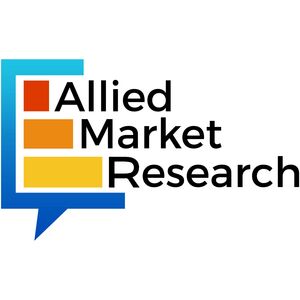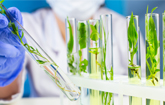Molecular spectroscopy is widely applied across pharmaceutical, biotechnology, chemical, environmental, and food industries due to its ability to analyze molecular structures, identify compounds, and monitor chemical processes with high precision. Techniques such as UV-Vis, infrared (IR), nuclear magnetic resonance (NMR), and Raman spectroscopy are used for applications including drug development, quality control, environmental testing, and material characterization. With growing demand for advanced analytical tools, increasing pharmaceutical R&D, and expanding uses in biotechnology and clinical diagnostics, molecular spectroscopy continues to gain traction across healthcare, environmental monitoring, and industrial research segments globally.
WILMINGTON, Del., Nov. 11, 2025 /PRNewswire/ -- Allied Market Research published a report, titled, "Molecular Spectroscopy Market by Technology (UV Visible Spectroscopy, Infrared Spectroscopy, Nuclear Magnetic Resonance Spectroscopy, Raman Spectroscopy, and Others), and Application (Pharmaceuticals and Biotechnology, Environmental Testing, Food and Beverage Testing, Academic and Research Institutes, and Others): Global Opportunity Analysis and Industry Forecast, 2025-2034". According to the report, the molecular spectroscopy market was valued at $3.9 billion in 2024, and is estimated to reach $6.4 billion by 2034, growing at a CAGR of 5% from 2025 to 2034.
Request Sample of the Report on Molecular Spectroscopy Market Forecast 2034 - https://www.alliedmarketresearch.com/request-sample/A34944
Market Introduction
The molecular spectroscopy market encompasses a diverse range of analytical technologies used to study the interaction of electromagnetic radiation with matter, enabling precise identification, structural characterization, and quantification of molecules. Core techniques include nuclear magnetic resonance (NMR), infrared (IR), ultraviolet-visible (UV-Vis), and Raman spectroscopy, each serving critical roles in pharmaceuticals, biotechnology, food safety, environmental monitoring, and academic research. Market growth is driven by rising demand for advanced drug discovery, stringent regulatory requirements for quality control, and expanding applications in nanotechnology and materials science. Recent developments include the introduction of portable and benchtop instruments, AI-driven data analysis, and cloud-enabled platforms for remote monitoring. Strategic collaborations, product innovations, and investments in R&D are reshaping the competitive landscape, while the growing emphasis on food and environmental safety and increased healthcare spending in emerging economies further strengthen market adoption and expansion globally.
Report Overview:
The molecular spectroscopy market is segmented into technology, application, and region. On the basis of technology, it is segmented into UV-visible spectroscopy, infrared (IR) spectroscopy, nuclear magnetic resonance (NMR) spectroscopy, Raman spectroscopy, and others. On the basis of application, the market is classified into pharmaceuticals & biotechnology, environmental testing, food & beverage testing, academic & research institutes, and others. Region-wise, the market is analyzed across North America (U.S., Canada, and Mexico), Europe (Germany, France, UK, Italy, Spain, and rest of Europe), Asia-Pacific (China, Japan, India, Australia, South Korea, and rest of Asia-Pacific), and LAMEA (Brazil, Saudi Arabia, South Africa, and rest of LAMEA).
- On the basis of technology, the NMR spectroscopy segment dominated the market in terms of revenue in 2024 However, Raman spectroscopy segment is anticipated to grow at the fastest CAGR during the forecast period.
- On the basis of application, the pharmaceuticals and biotechnology segment dominated the market in terms of revenue in 2024 and is anticipated to grow at the fastest CAGR during the forecast period.
- Region wise, North America generated the largest revenue in 2024. However, Asia-Pacific is anticipated to grow at the highest CAGR during the forecast period.
Report Coverage & Details
|
Report Coverage
|
Details
|
|
Forecast Period
|
2025–2034
|
|
Base Year
|
2024
|
|
Market Size in 2024
|
$3.9 billion
|
| Market Size in 2034 |
$6.4 billion
|
|
CAGR
|
5 %
|
|
No. of Pages in Report
|
278
|
|
Segments Covered
|
Technology, Application, and Region
|
|
Target Region / Countries
|
North America (U.S., Canada, and Mexico), Europe (Germany, France, UK, Italy, and rest of Europe), Asia-Pacific (Japan, China, India, Australia, and rest of Asia-Pacific), and LAMEA (Brazil, South Africa, Saudi Arabia, and Rest of LAMEA).
|
|
Drivers
|
Rise in Advancements in Technology
|
|
Growth in Applications in Pharmaceuticals and Biotechnology
|
|
|
Expanding Role in Environmental and Food Safety Testing
|
|
|
Opportunities
|
Growth opportunities in emerging markets
|
|
Restraints |
High Production Costs of Instruments |
Want to Explore More, Connect to our Analyst - https://www.alliedmarketresearch.com/connect-to-analyst/A34944
Market Growth & Opportunities Factors:
The molecular spectroscopy market is experiencing strong momentum, primarily due to the growing demand for precise analytical techniques in pharmaceuticals, biotechnology, food safety, and environmental monitoring. Spectroscopic methods such as nuclear magnetic resonance (NMR), infrared (IR), ultraviolet-visible (UV-Vis), and Raman spectroscopy are increasingly used in drug discovery, quality control, and advanced materials research. A key driver is the rising need for accurate molecular characterization to support regulatory compliance and ensure product safety across industries. The pharmaceutical sector, in particular, is witnessing increasing reliance on spectroscopy for biomolecular analysis, protein characterization, and metabolomics. Similarly, heightened global focus on environmental testing and food authenticity is expanding the scope of molecular spectroscopy in routine applications.
The market also presents lucrative opportunities driven by ongoing technological advancements. Innovations such as miniaturized and portable spectrometers, AI-integrated platforms, and cloud-enabled data sharing are enhancing accessibility and efficiency in laboratory and field testing. These developments are broadening adoption in resource-limited settings and real-time monitoring applications. Additionally, molecular spectroscopy is finding new frontiers in nanotechnology, semiconductor analysis, and forensic science, reflecting its versatility across emerging scientific domains. Growing investments in academic and industrial R&D, coupled with collaborations between instrument manufacturers and research institutes, are accelerating the development of next-generation spectroscopy systems. Expanding applications in personalized medicine and biomarker discovery further highlight the long-term opportunities in this field.
Major Challenges in Industry & Solutions:
Despite its promising growth, the molecular spectroscopy market faces several notable challenges. A primary concern is the high cost of advanced spectroscopy instruments, particularly NMR and Raman systems, which can limit adoption in small laboratories and emerging economies. To address this, companies are investing in the development of compact, cost-effective devices without compromising accuracy. Leasing models, shared laboratory facilities, and academic–industry collaborations are also emerging as solutions to improve accessibility.
Another challenge lies in the complexity of data interpretation, especially with multi-dimensional spectroscopy outputs, which can hinder usability among non-specialist end users. To overcome this, vendors are increasingly integrating artificial intelligence and machine learning into spectroscopy software, simplifying data analysis and improving accuracy. Enhanced training programs and digital learning tools are also helping users maximize instrument efficiency and reliability.
For Purchase Related Queries/Inquiry - https://www.alliedmarketresearch.com/purchase-enquiry/A34944
Regional Insights
North America holds a dominant share in the molecular spectroscopy market, driven by advanced R&D infrastructure, strong pharmaceutical and biotechnology industries, and robust government funding for scientific research. The U.S. is a global leader in drug discovery, precision medicine, and environmental monitoring, all of which rely heavily on spectroscopy techniques. According to the National Science Foundation (NSF), U.S. federal agencies allocated over $42 billion to research and development in 2022, with a significant portion supporting advanced analytical instrumentation. This strong focus on innovation, combined with a growing number of FDA-regulated applications requiring spectroscopy for quality assurance, ensures sustained demand across sectors.
Europe remains a key contributor, supported by a well-established academic and research ecosystem, stringent regulatory frameworks for food safety and environmental monitoring, and strong pharmaceutical manufacturing capabilities. Countries such as Germany, Switzerland, and the UK are global hubs for chemical and life sciences research, driving steady demand for advanced spectroscopy tools. Regulatory mandates under the European Food Safety Authority (EFSA) and the EU's environmental policies have further fueled adoption in food authenticity testing and pollution monitoring. Strategic collaborations between European universities and instrument manufacturers are also accelerating innovations such as hybrid spectroscopic systems and AI-powered platforms.
The Asia-Pacific region is emerging as the fastest-growing market for molecular spectroscopy, propelled by rapid industrialization, growing pharmaceutical R&D, and increasing emphasis on quality testing in food and environmental sectors. China, Japan, and India are major contributors, with rising government initiatives to strengthen domestic scientific research infrastructure. For instance, China's 14th Five-Year Plan emphasizes advanced instrumentation development to reduce reliance on imports. Additionally, the region's booming biopharmaceutical sector and expanding academic research base are creating strong demand for cost-effective spectroscopy solutions. Companies are strategically partnering with local distributors and research institutes to enhance penetration in these high-growth markets. The expansion of medical tourism, increasing healthcare spending, and growing awareness of food and environmental safety are expected to further fuel adoption across Asia-Pacific in the coming years.
Major Global Key Players:
Between 2023 and 2025, product approval, product launch, agreement and acquisition have emerged as the most prominent activities in the Hyaluronic acid products market, enabling key players to expand their offerings and strengthen their market position. For instance, In April 2025, HORIBA, a global leader in analytical and measurement technologies, announced the launch of the PoliSpectra Rapid Raman Plate Reader (RPR) for Raman High-Throughput Screening (HTS). RPR technology enables efficient monitoring of bioprocesses and drug discovery workflows with rapid, non-destructive analysis of 96 wells within one minute.
The major players in the molecular spectroscopy industry include
- Bruker Corporation,
- Thermo Fisher Scientific Inc.,
- PerkinElmer Inc.,
- Agilent technologies, inc.,
- Shimadzu Corporation,
- ABB,
- JEOL Ltd.,
- HORIBA,
- JASCO, and
- VIAVI Solutions Inc.
Key Strategies Adopted by Competitors
- In March 2025, HORIBA, a global leader in analytical and measurement technology, announced an expanded portfolio of instruments tailored to meet the rigorous demands of the pharmaceutical industry. Its current suite of offerings encompasses applications across the entire pharmaceutical lifecycle—from drug discovery and development to manufacturing and quality control.
- In February 2025, Bruker Corporation announced the launch of the VERTEX NEO Platform, with its first product, the VERTEX NEO R. This release marks a continuation of providing high-end Fourier-Transform Infrared (FTIR) instrumentation for unparalleled and disturbance-free academic and industrial research and development.
- In April 2024, Bruker Corporation, the leading provider of nuclear magnetic resonance (NMR) spectroscopy solutions, announced the introduction of novel high-resolution solid-state NMR scientific capabilities that can enable unprecedented structural biology discoveries in large proteins, membrane proteins, and protein aggregates. It launched a new ultra-fast CP/MAS iProbe as the latest innovation in solid-state NMR technology. Featuring a 160 kHz Magic Angle Spinning (MAS) system, it takes high-resolution MAS and proton detection on solid biological samples to the next level, enabling new scientific discoveries.
- In February 2024, Bruker Corporation announced the launch of the new BEAM – the first dedicated single-point spectrometer unleashing the full power of FT-NIR spectroscopy, taking in-process control for solid samples to the next level. Unlike common single-point analyzers based on filter or diode-array technology, the BEAM uses FT-NIR technology based on Bruker's RockSolidTM interferometer to ensure it can perform the same applications with the same precision, accuracy, and long-term stability expected from a high-end lab-based system.
- In February 2024, Bruker Corporation announced the acquisition of Nanophoton Corporation, a pioneer focused on advanced research Raman microscopy systems. Headquartered in Osaka, Nanophoton offers a broad portfolio of advanced Raman microscopes, serving academic and industrial research customers, primarily in Japan. This acquisition fills a gap in Bruker's molecular microscopy portfolio, and Bruker is looking forward to offering fast, flexible, and sensitive Nanophoton Raman microscopy systems worldwide for research and development in life sciences, biopharma, advanced materials, semiconductors, and polymers.
- In January 2024, Bruker Corporation announced the acquisition of Tornado Spectral Systems Inc., a Canadian company specializing in process Raman instruments, primarily used in pharma and biotech quality control applications. Tornado, with over a decade of experience in innovative and industry-proven Raman solutions, will enhance Bruker's biopharma PAT portfolio with its well-established products.
- In April 2023, Bruker Corporation, at the Experimental Nuclear Magnetic Resonance Conference (ENC 2023), announced innovations for NMR spectroscopy in life science, pharma, and cleantech research to enable discoveries in functional structural biology, drug discovery, and battery research. It launched the Ascend Evo 400 new standard 400 MHz NMR magnet with a liquid helium hold-time of one year to reduce costs of ownership and enhance operational convenience.
- In April 2023, HORIBA, a global leader in analytical and measurement technology, announced the new LabRAM Odyssey, a fully automated and remotely controllable system. The LabRAM Odyssey replaces the best seller LabRAM HR Evolution. Developed on the same platform, the LabRAM Odyssey is now more user friendly and offers new functionalities, advanced confocal imaging capabilities in 2D and 3D, and is fully compliant with all market requirements.
Explore AMR's Extensive Ongoing Coverage on Life Science Industry:
Indonesia Beauty Supplements Market - https://www.alliedmarketresearch.com/indonesia-beauty-supplements-market-A16353
Cancer Supportive Care Drugs Market - https://www.alliedmarketresearch.com/cancer-supportive-care-drugs-market-A07133
Central Nervous Disorders Therapeutics market - https://www.alliedmarketresearch.com/central-nervous-disorders-therapeutics-market-A13121
Speech Therapy Market - https://www.alliedmarketresearch.com/speech-therapy-market-A31451
Microbiome Sequencing Market - https://www.alliedmarketresearch.com/microbiome-sequencing-market-A13576
AVENUE - A Subscription-Based Library (Premium on-demand, subscription-based pricing model) Offered by Allied Market Research:
AMR introduces its online premium subscription-based library on Avenue, designed specifically to offer cost-effective, one-stop solutions for enterprises, investors, and universities. With Avenue, subscribers can avail themselves of an entire repository of reports on more than 2,000 niche industries and more than 12,000 company profiles. Moreover, users can get online access to quantitative and qualitative data in PDF and Excel formats along with analyst support, customization, and updated versions of reports.
Get access to the library of reports at any time from any device and anywhere. For more details, follow the link: https://www.alliedmarketresearch.com/library-access
About Us
Allied Market Research (AMR) is a full-service market research and business consulting wing of Allied Analytics LLP based in Wilmington, Delaware. Allied Market Research provides end-to-end solutions along with information, education, advocacy, and networking resources to SMEs and early-stage start-ups to bring excellence to their processes. In addition, we offer a nurturing environment required to develop and grow businesses, including business planning; virtual support; market intelligence; acquiring resources; and getting direct access to finance, suppliers, and other experts to boost the growth of businesses and entrepreneurs.
Our bundled and hassle-free business support systems are customized to meet the needs of SME consultants and industry leaders. Moreover, our large network of skilled consultants and experts help start-ups get the business on a roll.
To find out more, visit www.alliedmarketresearch.com or follow us on Twitter, LinkedIn and Facebook.
Contact
David Correa
1209 Orange Street,
Corporation Trust Center,
Wilmington, New Castle,
Delaware 19801 USA.
Toll Free: +1-800-792-5285
Int'l: +1-503-894-6022
UK: +44-845-528-1300
Hong Kong: +852-301-84916
India (Pune): +91-20-66346060
Fax: +1-855-550-5975
help@alliedmarketresearch.com
Web: https://www.alliedmarketresearch.com
Logo: https://mma.prnewswire.com/media/636519/Allied_Market_Research_Logo.jpg







Share this article